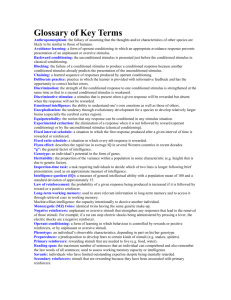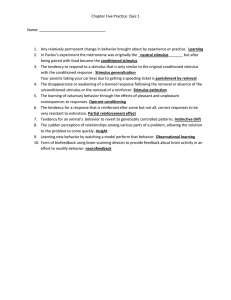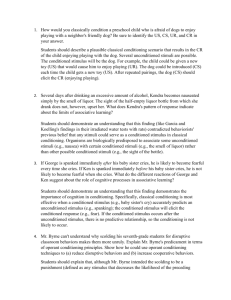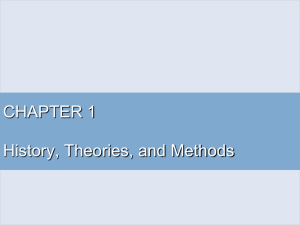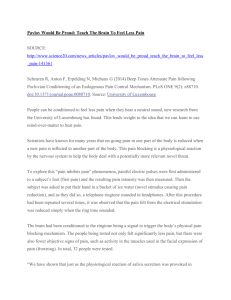Name: Date: CH. 6 Learning Active Review Behaviorists define
advertisement
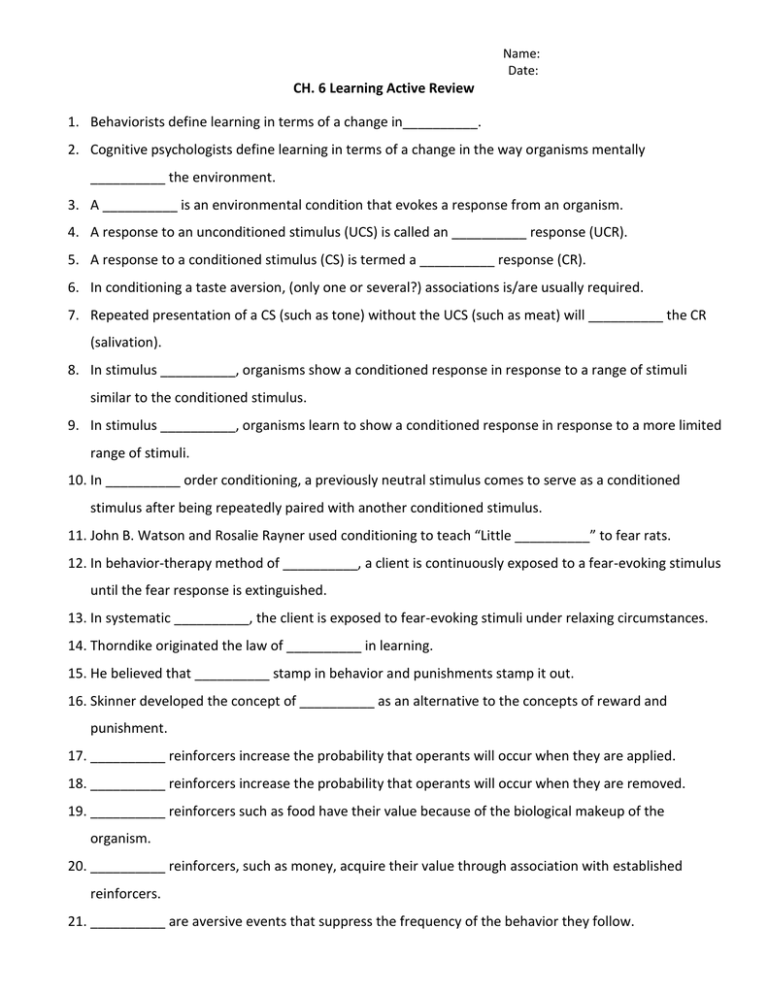
Name: Date: CH. 6 Learning Active Review 1. Behaviorists define learning in terms of a change in__________. 2. Cognitive psychologists define learning in terms of a change in the way organisms mentally __________ the environment. 3. A __________ is an environmental condition that evokes a response from an organism. 4. A response to an unconditioned stimulus (UCS) is called an __________ response (UCR). 5. A response to a conditioned stimulus (CS) is termed a __________ response (CR). 6. In conditioning a taste aversion, (only one or several?) associations is/are usually required. 7. Repeated presentation of a CS (such as tone) without the UCS (such as meat) will __________ the CR (salivation). 8. In stimulus __________, organisms show a conditioned response in response to a range of stimuli similar to the conditioned stimulus. 9. In stimulus __________, organisms learn to show a conditioned response in response to a more limited range of stimuli. 10. In __________ order conditioning, a previously neutral stimulus comes to serve as a conditioned stimulus after being repeatedly paired with another conditioned stimulus. 11. John B. Watson and Rosalie Rayner used conditioning to teach “Little __________” to fear rats. 12. In behavior-therapy method of __________, a client is continuously exposed to a fear-evoking stimulus until the fear response is extinguished. 13. In systematic __________, the client is exposed to fear-evoking stimuli under relaxing circumstances. 14. Thorndike originated the law of __________ in learning. 15. He believed that __________ stamp in behavior and punishments stamp it out. 16. Skinner developed the concept of __________ as an alternative to the concepts of reward and punishment. 17. __________ reinforcers increase the probability that operants will occur when they are applied. 18. __________ reinforcers increase the probability that operants will occur when they are removed. 19. __________ reinforcers such as food have their value because of the biological makeup of the organism. 20. __________ reinforcers, such as money, acquire their value through association with established reinforcers. 21. __________ are aversive events that suppress the frequency of the behavior they follow. Name: Date: 22. In a(n) __________ schedule, a specific amount of time must elapse since a previous correct response before reinforcement again becomes available. 23. In a(n) __________ schedule, the number of correct responses that must be performed before reinforcement becomes available is allowed to vary. 24. In shaping, we reinforce __________ approximations to the goal. 25. In using behavior __________, teachers reinforce desired behavior and extinguish undesired behavior by ignoring it. CH. 7 Memory Active Review 1. __________ memories are memories of specific information. 2. Memories of the events that happen are __________ memories. 3. __________ memories concern generalized knowledge. 4. __________ is the transforming of information so that we can remember it. 5. One way of storing information is by __________ rehearsal, or by mentally repeating it. 6. Another way of storing information is by __________ rehearsal, when we relate new information to things we already know. 7. The Atkinson-Shiffon model hypothesizes three stages of memory:__________, __________, and __________. 8. The mental representations of visual stimuli are referred to as__________. 9. __________ imagery is the ability to retain exact mental representations of visual stimuli over long amounts of time. 10. According to the__________-position effect, we are most likely to recall the first and last item in a series. 11. Loftus and other psychologists have shown that we __________ our memories according to our schemas. 12. Detailed memories of surprising, important, and emotional events are termed __________ memories. 13. The __________-of-the-tongue phenomenon is most likely due to incomplete learning. 14. __________-dependent memory refers to information better retrieved under the circumstances in which it was encoded and stored. 15. The hippocampus appears vital to the storage of (new or old) information. 16. The __________ seems to be involved in the formation of verbal memories. Name: Date: CH. 10 Learning Active Review 1. In __________ research, the same people are observed repeatedly over time. 2. In __________ research, people of different ages are observed and compared. 3. The __________ effect defines similarities in behavior among peers that stem from the fact that group members are approximately the same age. 4. Heavy maternal use of alcohol is linked to __________ alcohol syndrome (FAS). 5. Women who smoke cigarettes during pregnancy deprive their fetuses of __________, sometimes resulting in stillbirth and persistent academic problems. 6. Fetal exposure to heavy metals lead and mercury can (slow or accelerate?) mental development. 7. __________ are simple, unlearned stereotypical responses elicited by specific stimuli. 8. Neonates sleep for about __________ hours per day. 9. Babies usually __________ their birthweight in about 5 months and __________ it by their first birthday. 10. Infants seem to have an inborn preference for (simple or complex?) visual stimuli. 11. Piaget saw intelligence as including __________ (responding to events according to existing schemas) and accommodation. 12. Object permanence develops during the __________ period of cognitive development. 13. The __________-operational period is characterized by conservation and reversibility. 14. Vygotsky used the concepts of scaffolding and the __________ of proximal development to explain cognitive development. 15. Kohlberg hypothesizes that moral reasoning develops through (how many?) __________ levels and two stages within each level. 16. Erikson presents a theory of __________ development. 17. Ainsworth identified three stages of attachment: the __________ phase, which is characterized by indiscriminate attachment, the attachment-in-the-making phase, and the clear-cut-attachment phase. 18. The Harlow studies with monkeys suggest that __________ comfort is more important than conditioning in the development of attachment. 19. Ethologists argue that attachment is a(n) __________ that occurs during a critical period. 20. Baumrind labeled the three most important parenting styles __________, authoritarian, and permissive. Name: Date: CH. 11 Learning Active Review 1. Puberty begins with the appearance of __________ sex characteristics, such as the growth of body hair, deepening of the voice in males, and rounding of the breasts and hips in females. 2. The changes of puberty are stimulated by the __________ in the males and by estrogen and androgens in the female. 3. __________-operational thought is characterized by hypothetical thinking and deductive logic. 4. Adolescent egocentrism gives rise to the __________ audience and the personal fable. 5. In stage 6 moral reasoning, people consider behavior that is consistent with __________ ethical standards as right. 6. G. Stanley Hall described adolescence as a time of Sturm and Drang in German, which means storm and __________ in English. 7. Erik Erikson considers the life crisis of adolescence to be ego identity versus role __________. 8. Emerging adults tend to be found in (affluent or poor?) nations. 9. Emerging adulthood roughly spans the ages of 18 to __________. 10. According to Erikson, many people whom we would call emerging adults are in the identity status of __________. 11. In __________ adulthood, most people are at their height in sensory acuteness, reaction time, and cardiovascular fitness. 12. Young adults are (more or less?) egocentric than adolescents. 13. Erikson characterized early adulthood as the stage of __________ versus isolation. 14. Today, a (higher or lower?) percentage of young adults remain single for an extended period. 15. __________ intelligence refers to one’s lifetime of intellectual achievement as shown by vocabulary and general knowledge. 16. __________ intelligence is mental flexibility as shown by the ability to solve new kinds of problems. 17. Erikson labeled the life crisis of the middle years __________ versus stagnation. 18. According to __________ theories of aging, aging is determined by a genetic biological clock. 19. According to __________-and-tear theory, cells lose the ability to regenerate because of environmental factors such as pollution and disease. 20. Erikson labeled late adulthood the stage of ego __________ versus despair. 21. Successful agers optimize their strengths and __________ for the weaknesses. 22. Kubler-Ross’s stages of dying include __________, anger, bargaining, depression, and final acceptance.

